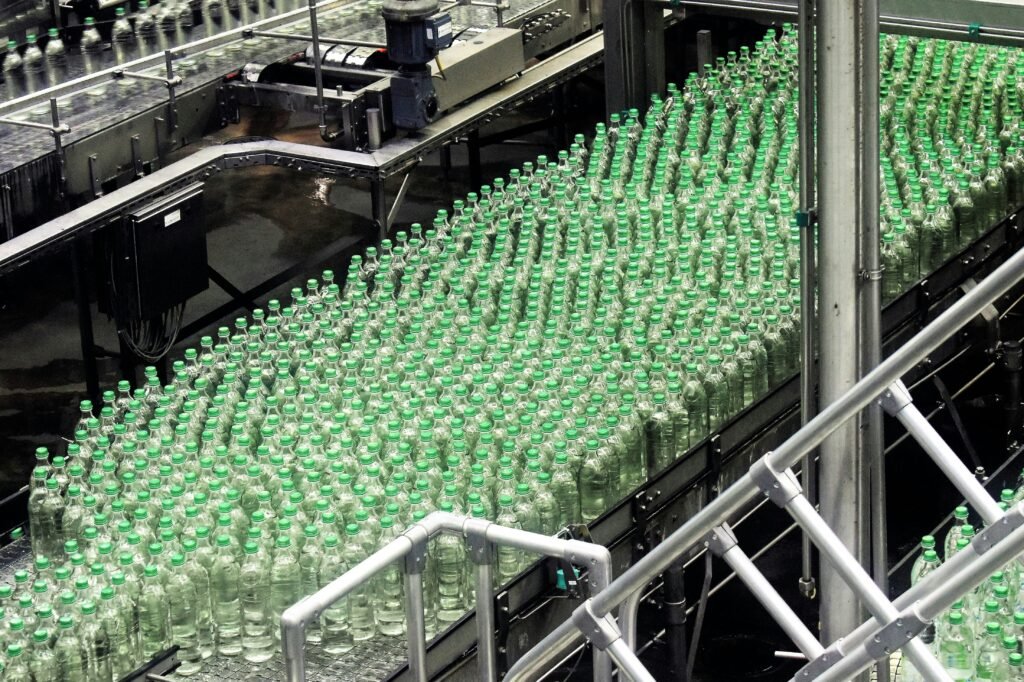In the increasingly eco-conscious world we live in, it is crucial to prioritize sustainability in every aspect of our lives. This holds especially true for industries such as plastic container production, which have historically been synonymous with environmental harm. However, with a growing awareness of the need for change, manufacturers are now actively working towards minimizing their environmental footprint. This article explores the various environmental considerations in plastic container production and highlights the innovative solutions being implemented to ensure a greener future for this industry.

This image is property of images.unsplash.com.
Material Selection
When it comes to minimizing the environmental footprint in plastic container production, one of the key considerations is the choice of materials. Opting for recyclable materials is an important step towards sustainability. By selecting materials that can be easily recycled, we can help reduce the amount of plastic waste that ends up in landfills or in our oceans. It’s essential to prioritize materials that have a higher chance of being recycled effectively.
In addition to choosing recyclable materials, it’s crucial to reduce the use of virgin plastic in container production. Virgin plastic refers to plastic that is made from new, non-recycled materials. By minimizing the use of virgin plastic, we can help conserve valuable resources and decrease the amount of energy required for production.
Exploring alternative materials is another aspect to consider. This involves looking beyond traditional plastics and exploring options like bio-based plastics or compostable materials. These alternatives offer the potential to reduce reliance on fossil fuels and provide more sustainable options for plastic container production.
Lastly, considering biodegradable options is essential for reducing the environmental impact of plastic container production. Biodegradable materials have the ability to break down naturally over time, reducing the accumulation of plastic waste in the environment. By choosing biodegradable materials, we can contribute to a more sustainable future.
Energy Efficiency
Implementing energy-efficient manufacturing processes is crucial for minimizing the environmental footprint in plastic container production. By adopting energy-saving techniques, such as optimizing machine operation and utilizing advanced technologies, we can reduce the amount of energy consumed during production.
Utilizing renewable energy sources is another effective strategy. By transitioning to renewable energy sources like solar or wind power, we can significantly decrease our dependency on fossil fuels and lower greenhouse gas emissions associated with plastic container production.
Another important aspect of energy efficiency is optimizing equipment and machinery. Regular maintenance and upgrades to machinery can help ensure they are operating at maximum efficiency, reducing energy waste.
Reducing energy consumption in transportation is also vital. By optimizing logistics and implementing fuel-efficient transportation methods, we can minimize the carbon footprint associated with delivering plastic containers to customers.

This image is property of images.unsplash.com.
Water Conservation
Water conservation plays a crucial role in minimizing the environmental impact of plastic container production. Implementing water recycling systems allows us to reuse water in various stages of production, significantly reducing overall water consumption. By treating and reusing wastewater, we can further decrease our reliance on freshwater sources.
Reducing water usage in production processes is another important step. By implementing water-saving technologies and practices, such as using low-flow faucets and optimizing cooling systems, we can reduce the amount of water needed for manufacturing plastic containers.
Implementing wastewater treatment systems is essential to ensure that any water discharged from the production process meets environmental standards. These systems help remove pollutants from wastewater, protecting ecosystems and water sources.
Optimizing water usage in cleaning and sterilization is another aspect of water conservation. By implementing efficient cleaning methods and reducing water waste during the cleaning process, we can contribute to a more sustainable production process.
Waste Management
Effective waste management is essential for minimizing the environmental footprint of plastic container production. Implementing recycling programs within the production facility allows us to divert plastic waste from landfills and promote a circular economy.
Reducing waste during production should be a priority. By optimizing production processes, we can minimize the generation of waste and maximize resource efficiency. This involves evaluating and improving manufacturing procedures to eliminate unnecessary waste and increase material utilization.
Collaborating with waste management facilities is another important aspect of waste management. By working together with specialized facilities, we can ensure that plastic waste is properly handled and recycled. This collaboration can also help identify opportunities for improvement throughout the waste management process.

This image is property of images.unsplash.com.
Product Design
Designing plastic containers with reusability and durability in mind is a key step towards minimizing their environmental impact. By creating containers that can withstand multiple uses, we can extend their lifespan and reduce the need for constant production and disposal.
Optimizing container shapes to reduce material usage is another important consideration. By carefully designing containers to maximize volume and minimize material requirements, we can decrease the overall amount of plastic needed for production.
Exploring lightweight design options is also beneficial. Lighter containers require less material and energy during production, reducing their carbon footprint. However, it’s important to ensure that the lightweight design does not compromise the durability and functionality of the containers.
Increasing the use of post-consumer recycled materials is another effective strategy. By incorporating recycled materials into the production of plastic containers, we can help close the loop and reduce the demand for virgin plastic.
Supply Chain Optimization
Reducing transportation distance is a critical factor in minimizing the environmental impact of plastic container production. By sourcing materials from local suppliers and reducing the overall distance traveled, we can decrease carbon emissions associated with transportation.
Implementing efficient logistics is another important consideration. By optimizing transportation routes, consolidating shipments, and utilizing alternative transportation methods like rail or sea, we can reduce the environmental footprint of transporting plastic containers.
Collaborating with suppliers is essential for reducing the overall environmental impact of plastic container production. By working closely with suppliers, we can encourage and support their efforts to implement sustainable practices and reduce their own environmental footprint.
Exploring local sourcing options is also beneficial. By sourcing materials and components from local suppliers, we can decrease the reliance on long-distance transportation and support the local economy.
Environmental Impact Assessment
Conducting life cycle assessments is a valuable tool in understanding and minimizing the environmental impacts of plastic container production. Life cycle assessments analyze the entire life cycle of a product, from raw material extraction to disposal, and can help identify opportunities for improvement.
Monitoring and evaluating environmental impacts is an ongoing process. By tracking and analyzing data related to energy consumption, water usage, waste generation, and greenhouse gas emissions, we can identify areas where improvements can be made and set meaningful sustainability goals.
Implementing continuous improvement strategies is essential for reducing the environmental footprint of plastic container production. By regularly reviewing and updating processes, technologies, and practices, we can ensure that our operations are continually evolving towards greater sustainability.
Setting sustainability goals provides a clear direction and purpose in minimizing the environmental impact of plastic container production. By establishing targets for energy efficiency, water conservation, waste reduction, and other sustainability metrics, we can work towards specific objectives and measure our progress.
Regulatory Compliance
Complying with environmental regulations is a fundamental aspect of responsible plastic container production. By staying informed and meeting all relevant regulations, we can ensure that our operations are in full compliance and that we are minimizing our environmental impact.
Staying updated on evolving regulations is crucial. Environmental regulations are continuously evolving, and it is essential to remain informed and adapt our practices accordingly. By staying ahead of changes in regulations, we can proactively implement necessary adjustments to ensure compliance.
Participating in industry sustainability initiatives is another important aspect of regulatory compliance. By actively engaging in industry-led programs and initiatives, we can share best practices, learn from others, and contribute to the development of sustainable standards and practices within the plastic container production industry.
Implementing responsible manufacturing practices involves going beyond minimum regulatory requirements and taking additional voluntary actions to reduce our environmental impact. This includes adopting sustainable practices, investing in upgrades and improvements, and prioritizing social and environmental responsibility.
Consumer Education and Engagement
Raising awareness about the environmental footprint of plastic containers is essential for engaging consumers in sustainability initiatives. By providing information on the environmental impact of plastic containers, we can empower consumers to make more informed choices and encourage them to prioritize sustainability.
Providing consumer information on recycling and disposal is crucial for promoting responsible and proper handling of plastic containers. Clear instructions on how to recycle or dispose of plastic containers can help prevent them from ending up in landfills or polluting the environment.
Encouraging responsible use and disposal of containers is another important aspect of consumer education. By promoting practices such as reusing containers, reducing single-use plastic, and properly disposing of containers, we can empower consumers to become active participants in minimizing the environmental footprint of plastic container production.
Engaging consumers in sustainability initiatives can further enhance their involvement. By creating opportunities for consumers to participate in recycling programs, sustainability campaigns, or feedback initiatives, we can foster a sense of ownership and collaboration in our sustainability efforts.
Investment in Research and Development
Funding research for innovative and sustainable plastic container materials is crucial for driving progress in the industry. By investing in research and development, we can support the development of new materials that are more environmentally friendly, durable, and cost-effective.
Supporting technological advancements in recycling processes is another important area of research and development investment. By improving recycling technologies and processes, we can enhance the efficiency and effectiveness of plastic container recycling, further contributing to a circular economy.
Exploring new production techniques is essential for continuous improvement and innovation. By investing in research and development, we can explore alternative manufacturing processes that are more energy-efficient, resource-efficient, and have a reduced environmental footprint.
Investing in sustainable packaging solutions is vital for the future of plastic container production. By exploring and supporting the development of sustainable packaging alternatives, such as compostable or bio-based materials, we can contribute to a more sustainable industry and promote a circular economy mindset.
By implementing strategies in material selection, energy efficiency, water conservation, waste management, product design, supply chain optimization, environmental impact assessment, regulatory compliance, consumer education and engagement, and research and development, we can work towards minimizing the environmental footprint in plastic container production. With a comprehensive and holistic approach, we can ensure that our production processes are more sustainable, responsible, and environmentally friendly.
